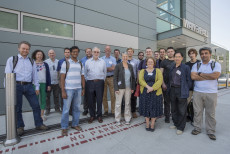Berkeley Lab Hosts UK Scientific Technology Facilities Council
September 12, 2016
Linda Vu, lvu@lbl.gov, 510.495.2402
Twelve members of the UK’s Science and Technology Facilities Council (STFC) visited Lawrence Berkeley National Laboratory (Berkeley Lab) on September 6-7 for a workshop with Berkeley Lab scientists to discuss approaches for managing and analyzing the deluge of data being produced by current and next-generation synchrotron light sources.
During the visit, staff from Berkeley Lab’s Computational Research Division (CRD), National Energy Research Scientific Computing Center (NERSC), Energy Sciences Network (ESnet) and Advanced Light Source (ALS) talked about some of their pioneering work. These methods include new computational methods developed by Berkeley Lab’s Center for Advanced Mathematics for Energy Research Applications (CAMERA) for extracting information from light source data; SPOT Suite, a set of software tools that allows ALS users to view real time results during beamline experiments, analyze experimental data, as well as easily manage and share their experimental and simulation data; and Berkeley Lab’s vision for “superfacilities” that will link multiple user facilities together to provide integrated scientific and computational capabilities to future science users.

David Skinner (right) takes STFC visitors on a tour of NERSC. (Photo by Marilyn Chung, Berkeley Lab)
Staff from STFC also presented some of the application and modeling tools that they use to analyze data from the UK’s Diamond Light Source, Central Laser Facility and ISIS neutron source. In breakout sessions, participants from both organizations discussed strategies and approaches to scientific data management, data analysis and scientific engagement. By the end of the visit, all participants left with a document outlining ideas for following up on various topics shared during the workshop.
“One of the biggest bottlenecks to science from the big facilities is access to computing resources, including skilled staff,” says David Corney, Director of STFC's Scientific Computing Department. "We came to Berkeley Lab because it’s very similar to our organization. By visiting, we hope to have a better understanding of how Berkeley run their synchrotron and what tools they use to manage and analyze the data. We want to get some ideas that we can take back and apply, we also hope to share some of our expertise as well.”

Michael Banda, Deputy Division Director of the ALS (left), takes STFC visitors on a tour of the synchrotron light source at Berkeley Lab. (Photo by Marilyn Chung, Berkeley Lab.)
This STFC visit follows a tour of European light sources that Berkeley Lab’s David Brown, Craig Tull and Alexander Hexemer took in 2014. The goal of that visit was to understanding what kind of hardware and software these facilities used, how they managed their data and workflows and to what extent the facilities worked closely with high performance computing centers.
“The increasing size and complexity of scientific data is a challenge that researchers worldwide are struggling with, not just in the US,” says David Brown, CRD Director. “I think one of the major takeaways from this recent STFC visit and our visit to the European light sources several years ago is that there is a lot that we can learn from each other, and plenty of opportunities to collaborate and come up with effective solutions for everyone.”
About Computing Sciences at Berkeley Lab
High performance computing plays a critical role in scientific discovery. Researchers increasingly rely on advances in computer science, mathematics, computational science, data science, and large-scale computing and networking to increase our understanding of ourselves, our planet, and our universe. Berkeley Lab’s Computing Sciences Area researches, develops, and deploys new foundations, tools, and technologies to meet these needs and to advance research across a broad range of scientific disciplines.







 Instagram
Instagram YouTube
YouTube